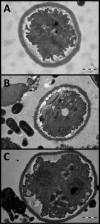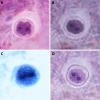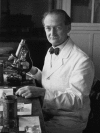Dientamoeba fragilis, the Neglected Trichomonad of the Human Bowel
- PMID: 27170141
- PMCID: PMC4861990
- DOI: 10.1128/CMR.00076-15
Dientamoeba fragilis, the Neglected Trichomonad of the Human Bowel
Abstract
Dientamoeba fragilis is a protozoan parasite of the human bowel, commonly reported throughout the world in association with gastrointestinal symptoms. Despite its initial discovery over 100 years ago, arguably, we know less about this peculiar organism than any other pathogenic or potentially pathogenic protozoan that infects humans. The details of its life cycle and mode of transmission are not completely known, and its potential as a human pathogen is debated within the scientific community. Recently, several major advances have been made with respect to this organism's life cycle and molecular biology. While many questions remain unanswered, these and other recent advances have given rise to some intriguing new leads, which will pave the way for future research. This review encompasses a large body of knowledge generated on various aspects of D. fragilis over the last century, together with an update on the most recent developments. This includes an update on the latest diagnostic techniques and treatments, the clinical aspects of dientamoebiasis, the development of an animal model, the description of a D. fragilis cyst stage, and the sequencing of the first D. fragilis transcriptome.
Copyright © 2016, American Society for Microbiology. All Rights Reserved.
Figures













References
-
- Jepps MW, Dobell C. 1918. Dientamoeba fragilis n.g., n. sp.: a new intestinal amoeba from man. Parasitology 10:352–367.
-
- Dobell C. 1940. Researches on intestinal protozoa in monkeys and man. X. The life history of Dientamoeba fragilis: observations, experiments and speculations. Parasitology 32:417–461.
-
- Ockert G, Schneider W. 1974. Electron microscopic findings in Dientamoeba fragilis. Z Gesamte Hyg 20:555–557. (In German.). - PubMed
-
- Silard R, Burghelea B, Panaitescu D, Burcos V. 1984. Ultrastructure of Dientamoeba fragilis: a study of the mononucleated stage. Arch Roum Pathol Exp Microbiol 43:87–101. - PubMed
Publication types
MeSH terms
LinkOut - more resources
Full Text Sources
Other Literature Sources

